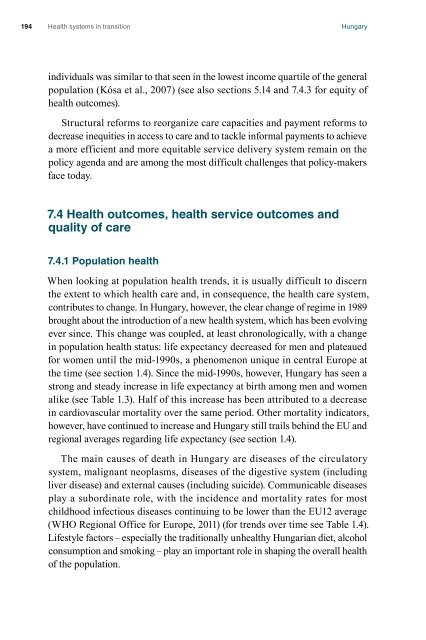Health Systems in Transition - Hungary - World Health Organization ...
Health Systems in Transition - Hungary - World Health Organization ...
Health Systems in Transition - Hungary - World Health Organization ...
Create successful ePaper yourself
Turn your PDF publications into a flip-book with our unique Google optimized e-Paper software.
194<br />
<strong>Health</strong> systems <strong>in</strong> transition <strong>Hungary</strong><br />
<strong>in</strong>dividuals was similar to that seen <strong>in</strong> the lowest <strong>in</strong>come quartile of the general<br />
population (Kósa et al., 2007) (see also sections 5.14 and 7.4.3 for equity of<br />
health outcomes).<br />
Structural reforms to reorganize care capacities and payment reforms to<br />
decrease <strong>in</strong>equities <strong>in</strong> access to care and to tackle <strong>in</strong>formal payments to achieve<br />
a more efficient and more equitable service delivery system rema<strong>in</strong> on the<br />
policy agenda and are among the most difficult challenges that policy-makers<br />
face today.<br />
7.4 <strong>Health</strong> outcomes, health service outcomes and<br />
quality of care<br />
7.4.1 Population health<br />
When look<strong>in</strong>g at population health trends, it is usually difficult to discern<br />
the extent to which health care and, <strong>in</strong> consequence, the health care system,<br />
contributes to change. In <strong>Hungary</strong>, however, the clear change of regime <strong>in</strong> 1989<br />
brought about the <strong>in</strong>troduction of a new health system, which has been evolv<strong>in</strong>g<br />
ever s<strong>in</strong>ce. This change was coupled, at least chronologically, with a change<br />
<strong>in</strong> population health status: life expectancy decreased for men and plateaued<br />
for women until the mid-1990s, a phenomenon unique <strong>in</strong> central Europe at<br />
the time (see section 1.4). S<strong>in</strong>ce the mid-1990s, however, <strong>Hungary</strong> has seen a<br />
strong and steady <strong>in</strong>crease <strong>in</strong> life expectancy at birth among men and women<br />
alike (see Table 1.3). Half of this <strong>in</strong>crease has been attributed to a decrease<br />
<strong>in</strong> cardiovascular mortality over the same period. Other mortality <strong>in</strong>dicators,<br />
however, have cont<strong>in</strong>ued to <strong>in</strong>crease and <strong>Hungary</strong> still trails beh<strong>in</strong>d the EU and<br />
regional averages regard<strong>in</strong>g life expectancy (see section 1.4).<br />
The ma<strong>in</strong> causes of death <strong>in</strong> <strong>Hungary</strong> are diseases of the circulatory<br />
system, malignant neoplasms, diseases of the digestive system (<strong>in</strong>clud<strong>in</strong>g<br />
liver disease) and external causes (<strong>in</strong>clud<strong>in</strong>g suicide). Communicable diseases<br />
play a subord<strong>in</strong>ate role, with the <strong>in</strong>cidence and mortality rates for most<br />
childhood <strong>in</strong>fectious diseases cont<strong>in</strong>u<strong>in</strong>g to be lower than the EU12 average<br />
(WHO Regional Office for Europe, 2011) (for trends over time see Table 1.4).<br />
Lifestyle factors – especially the traditionally unhealthy Hungarian diet, alcohol<br />
consumption and smok<strong>in</strong>g – play an important role <strong>in</strong> shap<strong>in</strong>g the overall health<br />
of the population.
















